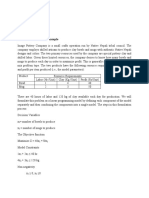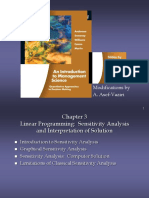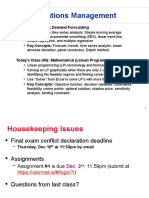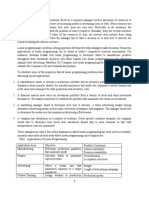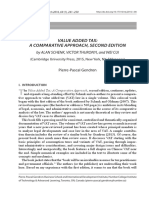Linear Programming: After Completing This Chapter, Students Will Be Able To
Uploaded by
UTTAM KOIRALALinear Programming: After Completing This Chapter, Students Will Be Able To
Uploaded by
UTTAM KOIRALALinear Programming
After completing this chapter, students will be able to:
1. Understand the basic assumptions and properties of linear
programming (LP)
2. Graphically solve any LP problem that has only two variables
by both the corner point and isoprofit line methods
3. Understand special issues in LP such as infeasibility,
unboundedness, redundancy, and alternative optimal
solutions
4. Understand the role of sensitivity analysis
4/28/2020 Prepared by: Pravat Uprety 1
Formulating LP Problems
• One of the most common LP applications is the product
mix problem
• Two or more products are produced using limited
resources such as personnel, machines, and raw
materials
• The profit that the firm seeks to maximize is based on
the profit contribution per unit of each product
• The company would like to determine how many units
of each product it should produce so as to maximize
overall profit given its limited resources
4/28/2020 Prepared by: Pravat Uprety 2
Flair Furniture Company
The Flair Furniture Company produces inexpensive tables
and chairs
Processes are similar in that both require a certain amount
of hours of carpentry work and in the painting and
varnishing department
Each table takes 4 hours of carpentry and 2 hours of
painting and varnishing
Each chair requires 3 of carpentry and 1 hour of painting
and varnishing
There are 240 hours of carpentry time available and 100
hours of painting and varnishing
Each table yields a profit of $70 and each chair a profit of
$50
4/28/2020 Prepared by: Pravat Uprety 3
Flair Furniture Company
The company wants to determine the best combination of tables and chairs to
produce to reach the maximum profit
HOURS REQUIRED TO
PRODUCE 1 UNIT
(T) (C) AVAILABLE HOURS
DEPARTMENT TABLES CHAIRS THIS WEEK
Carpentry 4 3 240
Painting and varnishing 2 1 100
Profit per unit $70 $50
4/28/2020 Prepared by: Pravat Uprety 4
Flair Furniture Company
The decision variables representing the actual decisions we
will make are
T = number of tables to be produced per week
C = number of chairs to be produced per week
The objective is to
Maximize profit
The constraints are
1. The hours of carpentry time used cannot exceed 240
hours per week
2. The hours of painting and varnishing time used
cannot exceed 100 hours per week
The values for T and C must be nonnegative
T ≥ 0 (number of tables produced is greater than or equal to 0)
C ≥ 0 (number of chairs produced is greater than or equal to 0)
4/28/2020 Prepared by: Pravat Uprety 5
Flair Furniture Company
Decision Variable
T = number of tables to be produced per week
C = number of chairs to be produced per week
Maximize profit = $70T + $50C
subject to
4T + 3C ≤240 (carpentry constraint)----------- -(1)
2T + 1C ≤100 (painting and varnishing constraint)—(2)
T, C ≥ 0 (non negativity constraint)
4/28/2020 Prepared by: Pravat Uprety 6
Software Solution (LINDO)
Max 70T +50C
Subject to
4T + 3C ≤ 240 (carpentry constraint)-----------(1) Row 2
2T + 1C ≤ 100 (painting and constraint)—……(2) Row 3
LP OPTIMUM FOUND AT STEP 2
OBJECTIVE FUNCTION VALUE
1) 4100.000 Optimal Value (OV = 4100)
VARIABLE VALUE REDUCED COST
T 30.000000 0.000000
C 40.000000 0.000000 Optimal Solution (T= 30 and C = 40)
For active there is dual
ROW SLACK OR SURPLUS DUAL PRICES
(One unit increase in
2) 0.000000 15.000000 RHS of 1st constraint
3) 0.000000 5.000000 increases the profit by
15 Rs
• Both are active constraints (0 Slack/surplus means active and non zero means inactive)
4/28/2020 Prepared by: Pravat Uprety 7
RANGES IN WHICH THE BASIS IS UNCHANGED:
OBJ COEFFICIENT RANGES
VARIABLE CURRENT ALLOWABLE ALLOWABLE
COEF INCREASE DECREASE
T 70.000000 30.000000 3.333333
C 50.000000 2.500000 15.000000
RIGHTHAND SIDE RANGES
ROW CURRENT ALLOWABLE ALLOWABLE
RHS INCREASE DECREASE
2 240.000000 60.000000 40.000000
3 100.000000 20.000000 20.000000
4/28/2020 Prepared by: Pravat Uprety 8
Active and Inactive Constraints
• Active and Inactive Constraints
If, at optimality (i.e. when evaluated at the optimal solution),
the left hand side of a constraint equals the right hand side,
that constraint is said to be active, or binding. Thus, an
equality constraint is always active. An inequality constraint
may or may not be active.
Geometrically, an active constraint is one that passes through
the optimal solution.
If a constraint is not active, it is said to be inactive.
Geometrically, an inactive constraint is one that does not pass
through the optimal solution.
4/28/2020 Prepared by: Pravat Uprety 9
Slack (RHS –LHS for ≤ type for inactive constraints)
• For a constraint of the ≤ type, the difference between the
right hand side and the left hand side (the amount
unused) is called slack. Hence slack relates to a ≤
constraint; it is the amount of a constraint that is unused
by a solution.
For example, if one constraint in a problem is that ≤ 100
hours and the solution requires the use of 90 hours of
labor, then we can say that the labor constraint has a slack
of 10 hours. Thus, slack is the amount by which the left-
hand side of a ≤ constraint is less than the right-hand side
of the constraint.
4/28/2020 Prepared by: Pravat Uprety 10
Surplus (LHS –RHS for ≥ type for inactive constraints)
• For a constraint of ≥ type, the difference between the
left hand and the right hand side (the excess) is called
surplus. Hence surplus relates to a ≥ constraint; it is the
amount by which a constraint is exceeded by a solution.
For example, if a constraint requires that the number of
units of product A that are made be ≥ 10, and a solution
results in 12 units being produced, we can say that there
is a surplus of 2 units. Thus, surplus is the amount by
which the left hand side of ≥ constraint exceeds the right
hand side.
4/28/2020 Prepared by: Pravat Uprety 11
Sensitivity Analysis
• Optimal solutions to LP problems thus far have been found
under what are called deterministic assumptions
• This means that we assume complete certainty in the data
and relationships of a problem
• But in the real world, conditions are dynamic and changing
• We can analyze how sensitive a deterministic solution is to
changes in the assumptions of the model
• This is called sensitivity analysis, postoptimality analysis,
parametric programming, or optimality analysis
4/28/2020 Prepared by: Pravat Uprety 12
Sensitivity Analysis
Change In Impact On OS Impact On OV
R H S of active constraint Yes Yes
(By dual price amount)
R H S of Inactive Constraint No No
(Dual price is zero)
Coefficient of Objective No Yes
Function (By putting the value of OS)
(Applicable within the
given range)
4/28/2020 Prepared by: Pravat Uprety 13
High Note Sound Company
• The High Note Sound Company manufactures quality CD
players and stereo receivers
• Products require a certain amount of skilled artisanship
which is in limited supply
• The firm has formulated the following product mix LP model
Maximize profit = $50X1 + $120X2
Subject to 2X1 + 4X2 ≤ 80
(hours of electrician’s
time available)
3X1 + 1X2 ≤ 60
(hours of audio
technician’s time
available)
4/28/2020 Prepared by: Pravat Uprety X1, X2 ≥0 14
Software Output
max 50X1 + 120X2
Subject to
2X1 + 4X2 <= 80
3X1 + 1X2 <= 60
LP OPTIMUM FOUND AT STEP 1
OBJECTIVE FUNCTION VALUE
1) 2400.000
VARIABLE VALUE REDUCED COST
X1 0.000000 10.000000
X2 20.000000 0.000000
Optimal Solution (X1 = 0 and X2 = 20)
4/28/2020 Prepared by: Pravat Uprety 15
Software Output
Row Slack/Surplus Dual Price
2 0.00 30.00
3 40.00 0.00
RANGES IN WHICH THE BASIS IS UNCHANGED:
OBJ COEFFICIENT RANGES
VARIABLE CURRENT ALLOWABLE ALLOWABLE
COEF INCREASE DECREASE
X1 50.000000 10.000000 INFINITY
X2 120.000000 INFINITY 20.000000
RIGHTHAND SIDE RANGES
ROW CURRENT ALLOWABLE ALLOWABLE
RHS INCREASE DECREASE
2 80.000000 160.000000 80.000000
3 60.000000 INFINITY 40.000000
4/28/2020 Prepared by: Pravat Uprety 16
Changes in Resources or Right-Hand-Side
Values
• The right-hand-side values of the constraints often
represent resources available to the firm
• If additional resources were available, a higher
total profit could be realized
• Sensitivity analysis about resources will help
answer questions about how much should be paid
for additional resources and how much more of a
resource would be useful
4/28/2020 Prepared by: Pravat Uprety 17
Changes in Resources or Right-Hand-Side
Values
• If the right-hand side of a constraint is changed, the
feasible region will change (unless the constraint is
redundant)
• Often the optimal solution will change
• The amount of change in the objective function value that
results from a unit change in one of the resources available
is called the dual price or dual value
• The dual price for a constraint is the improvement in the
objective function value that results from a one-unit
increase in the right-hand side of the constraint
4/28/2020 Prepared by: Pravat Uprety 18
Changes in Resources or Right-Hand-Side
Values
• However, the amount of possible increase in the right-hand
side of a resource is limited
• If the number of hours increased beyond the upper bound,
then the objective function would no longer increase by
the dual price
• There would simply be excess (slack) hours of a resource or
the objective function may change by an amount different
from the dual price
• The dual price is relevant only within limits
4/28/2020 Prepared by: Pravat Uprety 19
Practice Question
E = total number of units of E2ZP’s produced next month
F = total number of units of F5ZM’s produced next month
MAX 5000E+4000F
SUBJECT TO
MINPROD) E + F 5 Row 2 (Minimum Production)
MKTPOSN) E - 3F 0 Row 3 (Market Position)
CAPA) 10E + 15F 150 Row 4 (Capacity in Department A)
CAPB) 20E + 10F 160 Row 5 (Capacity in Department B)
TESTHRS) 30E + 10F 135 Row 6 (Testing Hours )
4/28/2020 Prepared by: Pravat Uprety 20
Output
OBJECTIVE FUNCTION VALUE
1) 50500.00
VARIABLE VALUE REDUCED COST
E 4.5000 0.0000
F 7.0000 0.0000
ROW SLACK OR SURPLUS DUAL PRICES
2 6.5000 0.0000
3 16.5000 0.0000
4 0.0000 150.0000
5 0.0000 175.0000
6 70.0000 0.0000
4/28/2020 Prepared by: Pravat Uprety 21
RANGES IN WHICH THE BASIS IS UNCHANGED:
OBJ COEFFICIENT RANGES
VARIABLE CURRENT ALLOWABLE ALLOWABLE
COEF INCREASE DECREASE
E 5000.00 3000.00 2333.33
F 4000.00 3500.00 1500.00
RIGHTHAND SIDE RANGES
ROW CURRENT ALLOWABLE ALLOWABLE
RHS INCREASE DECREASE
2 5.00 6.50 INFINITY
3 0.00 INFINITY 16.50
4 150.00 90.00 47.14
5 160.00 73.33 40.00
6 135.00 70.00 INFINITY
4/28/2020 Prepared by: Pravat Uprety 22
Questions
a) Interpret the optimal solution, also explain the implication of all
slack and surplus variables.
b) What is the most that CAT would be willing to pay for an
additional hour of labor for testing?
c) What is the most that CAT would be willing to pay for an
additional hour in department B?
d) If only 130 hours were available in department A, what would be
CAT‘s profits?
e) CAT enters into a new agreement with the union whereby the
total number of hours available for testing next month is 150
hours. How would this affect the profits that can be made by CAT?
f) If the profit of E2ZP falls to $4000 per unit, would it have any
impact on the profits? If so, what?
4/28/2020 Prepared by: Pravat Uprety 23
Thank You
4/28/2020 Prepared by: Pravat Uprety 24
You might also like
- Factors Influencing Purchase Decision: A Case Study of Tiktok Video Streaming PlatformNo ratings yetFactors Influencing Purchase Decision: A Case Study of Tiktok Video Streaming Platform13 pages
- Auditing A Practical Approach With Data Analytics, 2e Raymond Johnson, Laura Wiley0% (1)Auditing A Practical Approach With Data Analytics, 2e Raymond Johnson, Laura Wiley64 pages
- Linear Programming Examples A Maximization Model Example100% (1)Linear Programming Examples A Maximization Model Example22 pages
- Linear Programming: Sensitivity Analysis and Interpretation of Solution100% (1)Linear Programming: Sensitivity Analysis and Interpretation of Solution56 pages
- Chapter 04 Sensitivity Analysis - An Applied ApproachNo ratings yetChapter 04 Sensitivity Analysis - An Applied Approach34 pages
- Linear Programming (LINDO Output) (Assignment Question 2 and 3)No ratings yetLinear Programming (LINDO Output) (Assignment Question 2 and 3)8 pages
- Linear Programming Sensitivity AnalysisNo ratings yetLinear Programming Sensitivity Analysis35 pages
- Linear Programming: Linear Programming (LP, Also Called Linear Optimization) Is A Method To Achieve The Best OutcomeNo ratings yetLinear Programming: Linear Programming (LP, Also Called Linear Optimization) Is A Method To Achieve The Best Outcome31 pages
- Part 3 Sensitivity and Duality AnalysisNo ratings yetPart 3 Sensitivity and Duality Analysis31 pages
- Terminology of Solutions For A LP Model: A SolutionNo ratings yetTerminology of Solutions For A LP Model: A Solution17 pages
- Operations Management: Previous Class (#8) : Demand ForecastingNo ratings yetOperations Management: Previous Class (#8) : Demand Forecasting69 pages
- Linear Programming Sensitivity Analysis: © 2007 Pearson EducationNo ratings yetLinear Programming Sensitivity Analysis: © 2007 Pearson Education37 pages
- Quantitative Methods For Business 11th Edition Anderson Test Bank - PDF Format Is Available With All ChaptersNo ratings yetQuantitative Methods For Business 11th Edition Anderson Test Bank - PDF Format Is Available With All Chapters67 pages
- 04 LP Sensitivity Analysis (20241105) (2)No ratings yet04 LP Sensitivity Analysis (20241105) (2)30 pages
- Shorter - Strategic Tools - Efe Ife Ie Space BCG QSPMNo ratings yetShorter - Strategic Tools - Efe Ife Ie Space BCG QSPM23 pages
- Sumitomo Corporation Background of CaseNo ratings yetSumitomo Corporation Background of Case14 pages
- Time Series Analysis: Second Degree EquationNo ratings yetTime Series Analysis: Second Degree Equation5 pages
- Linear Programming: After Completing This Chapter, Students Will Be Able ToNo ratings yetLinear Programming: After Completing This Chapter, Students Will Be Able To61 pages
- MTE - Spring 2020, Managerial AccountingNo ratings yetMTE - Spring 2020, Managerial Accounting6 pages
- Human Resource Management: Labor Relations and Collective BargainingNo ratings yetHuman Resource Management: Labor Relations and Collective Bargaining38 pages
- RMC No. 13-2020 Annex A - 1600-VT January 2018 ENCS PDF50% (2)RMC No. 13-2020 Annex A - 1600-VT January 2018 ENCS PDF2 pages
- Figure 1-2. Summary Flowchart of The EIA Process: Revised Procedural Manual For Dao 2003-30100% (1)Figure 1-2. Summary Flowchart of The EIA Process: Revised Procedural Manual For Dao 2003-301 page
- Dagupan Accountancy Review - Dare - May 2020 Cpa Exam "Dare Us To Bring Out The Best in You."No ratings yetDagupan Accountancy Review - Dare - May 2020 Cpa Exam "Dare Us To Bring Out The Best in You."14 pages
- Book Review: Value Added Tax: A Comparative Approach, Second EditionNo ratings yetBook Review: Value Added Tax: A Comparative Approach, Second Edition10 pages
- Uniform Allowance Undertaking-Circular No 38-17-Fin Dated 23-05-2017No ratings yetUniform Allowance Undertaking-Circular No 38-17-Fin Dated 23-05-20173 pages
- Goldman Prime Brokerage - Insights & Analytics Chart Pack April 2023No ratings yetGoldman Prime Brokerage - Insights & Analytics Chart Pack April 202330 pages
- The Rise of Crowd Logistics A New Way To Co Create Logistics ValueNo ratings yetThe Rise of Crowd Logistics A New Way To Co Create Logistics Value15 pages
- P13 - BPP - Billing and Interco - 018 - Reporting BillingNo ratings yetP13 - BPP - Billing and Interco - 018 - Reporting Billing11 pages
- Factors Influencing Purchase Decision: A Case Study of Tiktok Video Streaming PlatformFactors Influencing Purchase Decision: A Case Study of Tiktok Video Streaming Platform
- Auditing A Practical Approach With Data Analytics, 2e Raymond Johnson, Laura WileyAuditing A Practical Approach With Data Analytics, 2e Raymond Johnson, Laura Wiley
- Linear Programming Examples A Maximization Model ExampleLinear Programming Examples A Maximization Model Example
- Linear Programming: Sensitivity Analysis and Interpretation of SolutionLinear Programming: Sensitivity Analysis and Interpretation of Solution
- Chapter 04 Sensitivity Analysis - An Applied ApproachChapter 04 Sensitivity Analysis - An Applied Approach
- Linear Programming (LINDO Output) (Assignment Question 2 and 3)Linear Programming (LINDO Output) (Assignment Question 2 and 3)
- Linear Programming: Linear Programming (LP, Also Called Linear Optimization) Is A Method To Achieve The Best OutcomeLinear Programming: Linear Programming (LP, Also Called Linear Optimization) Is A Method To Achieve The Best Outcome
- Terminology of Solutions For A LP Model: A SolutionTerminology of Solutions For A LP Model: A Solution
- Operations Management: Previous Class (#8) : Demand ForecastingOperations Management: Previous Class (#8) : Demand Forecasting
- Linear Programming Sensitivity Analysis: © 2007 Pearson EducationLinear Programming Sensitivity Analysis: © 2007 Pearson Education
- Quantitative Methods For Business 11th Edition Anderson Test Bank - PDF Format Is Available With All ChaptersQuantitative Methods For Business 11th Edition Anderson Test Bank - PDF Format Is Available With All Chapters
- Practice Problems in Statistics and Data ReductionFrom EverandPractice Problems in Statistics and Data Reduction
- Shorter - Strategic Tools - Efe Ife Ie Space BCG QSPMShorter - Strategic Tools - Efe Ife Ie Space BCG QSPM
- Linear Programming: After Completing This Chapter, Students Will Be Able ToLinear Programming: After Completing This Chapter, Students Will Be Able To
- Human Resource Management: Labor Relations and Collective BargainingHuman Resource Management: Labor Relations and Collective Bargaining
- RMC No. 13-2020 Annex A - 1600-VT January 2018 ENCS PDFRMC No. 13-2020 Annex A - 1600-VT January 2018 ENCS PDF
- Figure 1-2. Summary Flowchart of The EIA Process: Revised Procedural Manual For Dao 2003-30Figure 1-2. Summary Flowchart of The EIA Process: Revised Procedural Manual For Dao 2003-30
- Dagupan Accountancy Review - Dare - May 2020 Cpa Exam "Dare Us To Bring Out The Best in You."Dagupan Accountancy Review - Dare - May 2020 Cpa Exam "Dare Us To Bring Out The Best in You."
- Book Review: Value Added Tax: A Comparative Approach, Second EditionBook Review: Value Added Tax: A Comparative Approach, Second Edition
- Uniform Allowance Undertaking-Circular No 38-17-Fin Dated 23-05-2017Uniform Allowance Undertaking-Circular No 38-17-Fin Dated 23-05-2017
- Goldman Prime Brokerage - Insights & Analytics Chart Pack April 2023Goldman Prime Brokerage - Insights & Analytics Chart Pack April 2023
- The Rise of Crowd Logistics A New Way To Co Create Logistics ValueThe Rise of Crowd Logistics A New Way To Co Create Logistics Value
- P13 - BPP - Billing and Interco - 018 - Reporting BillingP13 - BPP - Billing and Interco - 018 - Reporting Billing




